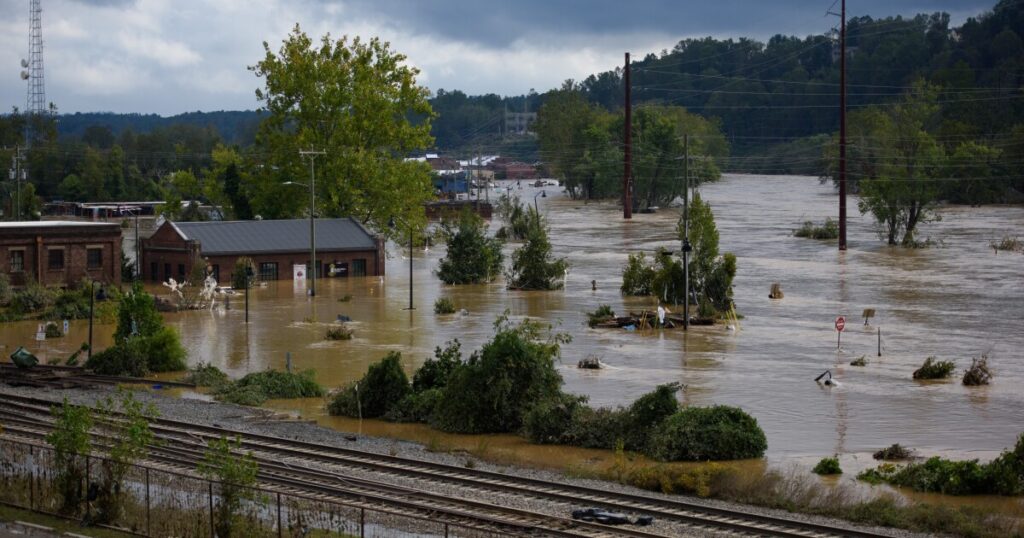Homebuyers drawn to Asheville are hit by Hurricane Helene

Enjoy complimentary access to top ideas and insights — selected by our editors.
(Bloomberg) –Nestled in North Carolina’s bucolic Blue Ridge mountains far from the coast, Asheville was supposed to be a refuge from extreme weather supercharged by climate change. Waves of tourists, retirees and affluent home buyers were drawn to the city’s arts scene, with the mild weather and altitude making it feel like a haven.
That illusion was ruined this past week. The destruction wrought by Hurricane Helene has been catastrophic — expansive flooding, wrecked roads, bridges, power lines and drinking water systems. At least 40 people are dead.
“You can’t escape climate change, you know, it’s everywhere,” said Jesse Keenan, a professor of sustainable real estate at Tulane University in New Orleans, who has long included Asheville on a list of top US cities for people seeking resilience to global warming. “There are places that are just better off than others, but even the places with comparatively lower risk still have risk.”
The horror Helene left in its wake has shocked the city of 94,000, and the inland devastation illustrates a broader danger about hurricanes. The storm has killed at least 139 in six states, according to the Associated Press, and most victims were hundreds of miles from the Florida Panhandle where the storm came ashore.
It’s a wake-up call for an area that’s been a magnet for wealthy homebuyers over the past decade. Ivester Jackson, which represents Christie’s International Real Estate in western North Carolina, lists 10 homes for $4.4 million or more in Asheville, including a $20 million mansion complete with a spa and massage, pedicure and manicure stations. Some 85 miles (137 kilometers) southwest, in the resort town of Highlands, N.C., a mountaintop mansion is listed for $49.99 million.
“It’s pretty alluring,” said Reed Jackson, managing partner at Ivester Jackson, “It’s been reasonably priced for a long time, if you compare it to some other areas, and so far it’s had a benign climate — this is kind of an anomaly.”
At the heart of Asheville’s renaissance is the River Arts District along the French Broad River, packed with artists’ studios, shops and restaurants. After Helene pushed through the area, dropping three days of intense rain, the river rose and rose.
As the waters swelled, Asheville resident Gray Jernigan watched and grew concerned. He and his wife and 2-year-old son had joined scores of people on a bridge as shipping containers, dumpsters and huge propane tanks floated by. Then buildings in the arts district began to collapse and slide into the river.
Jernigan had spent his career studying rivers for an environmental advocacy group in Asheville, but he was shocked by what he saw.
“It was just incredibly hard to comprehend the amount of water and the amount of destruction,” Jernigan, 39, said. “This storm — we are witnessing climate change.”
Back at home, Jernigan had no drinking water and the floodwaters seemed to be rising everywhere in town. He and his wife built a bonfire in the backyard, trying to distract their son. It didn’t work.
“We tried to stay calm for his sake,” Jernigan said.
By Sept. 29, after the city’s drinking water ran out, they decided it was time to go. Jernigan put his family in the car and drove east, to Raleigh, the state capital, to stay with his mother.
“It will be a long road and people are still suffering and are going to suffer for some time to come,” he said.
The devastation was vast. Most roads in and out of town were cut by the violent floods, including Interstate 40. Power outages and cell phone service were out almost everywhere.
“The pictures don’t fully capture the catastrophic damage that we’ve experienced here. It’s unprecedented,” Asheville Mayor Esther Manheimer told CNBC on Sept. 30. “No neighborhood has been spared, the power and water is out, and you know, we’re entering a desperate situation.”
Asheville is home to the US government’s climate data hub, the National Centers for Environmental Information. Computers were still off line as of midday on Sept. 30, leaving the agency unable to account for some employees and staff. Those who checked in safely are “generally without power, water or connectivity,” the agency said in a statement.
As the water recedes, reconstruction will bring its own challenges, said Keenan, the climate change migration expert at Tulane.
Many people will likely be unable to afford the cost of rebuilding to strict, flood-resistant standards, even if they have flood insurance. One likely outcome: More wealthy buyers will move in, following a pattern of gentrification seen after past disasters.
“We have a long history,” said Keenan, “where wealthy people come in and buy out people who just can’t afford to live there or are otherwise isolated.”
To contact the authors of this story:
Michael Smith in Miami at mssmith@bloomberg.net
Ari Natter in Washington at anatter5@bloomberg.net







